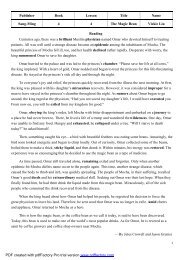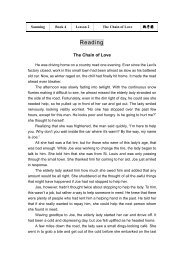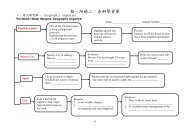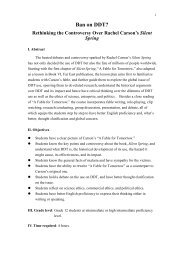檔案下載 - 普通高級中學課程英文學科中心網站
檔案下載 - 普通高級中學課程英文學科中心網站
檔案下載 - 普通高級中學課程英文學科中心網站
Create successful ePaper yourself
Turn your PDF publications into a flip-book with our unique Google optimized e-Paper software.
普 通 高 級 中 學 課 程 英 文 學 科 中 心101 年 度 優 良 教 學 示 例 徵 選 論 文“For or Against the Death Penalty?”A Journey in Reasoning and Critical Thinking in High SchoolEnglish ClassI. AbstractThe reading genres in Taiwan’s high school English textbooks are mainly“descriptions,” “narratives,” and “expositions.” However, the lesson—Should a KillerLive? Two Points of View—not only demonstrates a model of “argumentation” but italso covers the most heated issues—life and death education and law-relatededucation. To help students familiarize the structure of argumentation on the issue ofthe death penalty, I plan to provide interactive top-down activities. First, students willbe provided with bare facts to create their background knowledge about death penalty.Second, “mind-mapping” activity will be held to help students brainstorm. The mindmap is used to generate, visualize, structure, and classify death-penalty-related ideas.Third, different graphic organizers will be used to demonstrate the persuasivestructure in the reading, to show the coherence in the arguments, and to examinestudents’ comprehension of words. Fourth, an English debate is to be held for studentsto conduct teamwork, and to voice their thoughts and to listen to opposition. Last ofall, a guided-writing exercise is designed as an individual task for students to expresstheir own standpoints in a logical format. Though the title of the lesson seems shortand simple, I believe the educational meaning that the lesson plan embeds issubstantial and inspirational.II. Objectives:After the lesson, students will be able to:1. look at facts about the death penalty.2. probe into particular aspects of “life and death education,” and“law-related education.”3. discuss different perspectives and opinions on the death penalty.4. generate, visualize, structure, and classify death-penalty-related ideas bydrawing a “mind map.”5. familiarize the structure of argumentation and the format of persuasivewriting.6. practice critical thinking skills via using graphic organizers.1
7. learn the basic form of English debate.8. learn how to deal with conflict resolution.9. express their own standpoints in a logical format of writing.III. Grade Level & Description of Students:1. 11 th graders in high school, 45 students.2. PR 95~983. 25% of the students are advanced English learners, who can do independentEnglish reading/writing tasks under the teacher’s instructions. When they areasked to do oral presentation on stage, oftentimes they do well.4. Half of the students are high-intermediate English learners. They are able toread long passages, can predict the meaning of words or an outcome based onavailable information. They can produce short English passages to express theirown thoughts in both speaking and writing.5. However, around 5~7 students are low-intermediate, who can read shortpassages and write in simple English sentences but have a fear of speakingEnglish in public.6. All of the students are fond of learning with partners and doing group activitiesin class.7. They are also acquainted with the usage of PPT and graphic organizers.8. Most of the high-intermediate English learners are likely to spend 15 minutesreading the article for the first time.9. Most of them have never tried English debate before.IV. Time Required: 4 classes (50 minutes for each class)Time Teaching Focus ActivityThe1 stClassCreate BackgroundWhat do you know about deathpenalty?How do you feel about thephenomenon worldwide?Learn real cases in Taiwan.Brainstorm concept words relatedto the core word “Killer” bydrawing a mind-map. Prediction: “WhoHas Abolished DeathPenalty?” Group discussion:“Bare Facts”Vote for one’s ownopinionMind-mappingactivity.2
The2 ndClassThe3 rdClassThe4 thClassTeach New Information How do you differentiate thepoints of stance between pros andcons? What are the elements of a pieceof persuasive writing? How do you make a logicalstatement? How do you develop criticalthinking by using graphicorganizers?Practice and Personalization What are your statements of prosand cons? Categorize the vocabulary andcheck the comprehension ofwords. How do you conduct an Englishdebate? How do you express thoughts inthe English Debate?Application How do you conduct teamwork inan English debate? How do you voice your thoughtsand make rebuttal after listening toopposition? How do you think critically andsummarize what you haveobserved in a logical format? How do you use transitional wordsto make a persuasive writing? Homework: Previewthe lesson. Persuasive essaygraphic organizer ofPros and Cons(Worksheet #1) Make one’s ownstatements and share. Read the textbook. Homework:Worksheet # 2-1, 2-2 Check answers onthe homeworkworksheet #2-1, 2-2 Graphic organizer:Vocabularycategorizer(Worksheet #3) Review the text. Explain the processand rules of Englishdebate. Homework: Englishdebate preparation. English Debate Take notes Vote for winners Teacher’sconclusions andsharing. Homework: Writinga persuasive essay(Worksheet #4)3
V. Materials:1. Text book: Far East English Readers for Senior High Schools (Version B 施 玉惠 版 , ) Book 4 Lesson 4, “Should a Killer Live? Two Points of View”2. Worksheets and handouts3. A laptop4. ProjectorVI. Teaching Procedure(In accordance with the following critical thinking and creative thinking checklist)邏 輯 思 考 、 判 斷 與 創 造 力 檢 核 表 :1. 基 本 能 力 (1) 能 把 各 類 訊 息 加 以 比 較 、 歸 類 、 排 序 。 (2) 能 根 據 上 下 語 境 釐 清 不 同 訊 息 間 的 因 果 關 係 。 (3) 能 分 辨 客 觀 事 實 與 主 觀 意 見 。2. 進 階 能 力 (1) 能 分 析 、 歸 納 多 項 訊 息 的 共 通 點 或 結 論 。 (2) 能 將 習 得 的 原 則 類 推 到 新 情 境 中 , 解 決 問 題 。 (3) 能 綜 合 現 有 訊 息 , 預 測 可 能 的 發 展 。 (4) 能 評 估 不 同 資 訊 , 提 出 合 理 的 判 斷 或 建 議 。 (5) 能 整 合 、 規 劃 相 關 資 訊 及 資 源 , 並 發 揮 創 意 。4
A. Create Background1. “Who Has Abolished the Death Penalty?”Estimated Time: 10 minutes Materials: PPT (Appendix 1-1-1 ~ 1-1-3)對 照 指 標 :1-1, 1-2, 2-1Directions(1) Whole Class—Predict from the photo.The teacher shows the first PPT (Appendix 1-1-1), points out the title of the lessonand asks them whether they know the function of the chair on the PPT picture.- Answer: For execution of the death penalty in U.S.A.(2) Whole Class—Ask and discuss.Show the PPT (Appendix 1-1-2), and ask students to guess and choose the nationsthat have abolished the death penalty.Q: “Capital punishment—the legal killing of someone as punishment for acrime—is no longer practiced in many countries. Guess which nations havealready abolished the death penalty?”(3) The teacher announces the answers shown on the PPT (Appendix 1-1-2).(4) Pair Work—Discuss the possible reasons.The teacher shows the next PPT (Appendix 1-1-3). The teacher asks studentswhether they are surprised with the answers offered. Then, the teacher asksquestions and makes them discuss why some nations still have the death penaltywhile some have already abolished it?Q: According to the answers above, the people in Singapore and Japan are betterwell-educated and known for their law-abiding behaviors. Why do they stillretain the death penalty?Q: On the other hand, Mexico and Colombia are nations often related to drugs orguns, and their crime rates are relatively higher than Asian countries. In youropinion, why do they abolish the death penalty?[Notice]: There is no right or wrong answer to these questions. The reason why weask these questions is that students can find out that there is no arbitrary relation for acountry to decide whether they should retain or abolish the death penalty. It may be aresult of referendum, or a decision of policy. The answers vary. All in all, it indicatesthe controversy of this issue.5
2. “Bare Facts”Estimated Time: 20 minutes Materials: PPT (Appendix 1-2-1 ~ 1-2-3)對 照 指 標 :1-1, 2-1, 2-3, 2-4Directions:To create more background knowledge, the teacher provides three slides of bare factsabout the death penalty.(1) Whole Class—Predict and learn.1.1 The teacher shows a PPT with a world map (Appendix 1-2-1), in which all thecountries are divided into two colors. The color gray areas are the countriesthat have abolished the death penalty; the red areas are the countries whichstill retain the death penalty.1.2 The teacher asks students to guess which nations are on the top six of “DeathPenalty Execution in 2010” by showing them six blank columns on the worldmap.1.3 The teacher announces the answers by showing the name of each country. Inaddition, the teacher announces the numbers of execution in these sixcountries.[Notice]: The execution number (2000~8000/per year) in China is a special casethat the teacher can points out in particular.(2) Whole Class--Predict and learn.2.1 The teacher shows the PPT (Methods of execution) (Appendix 1-2-2) and asksstudents to name some methods of execution which they have known.2.2 The teacher shows the correct wording in English on the PPT.2.3 The teacher points out the current methods of execution used in Taiwan. (Seewhere the arrows point on the PPT)(3) Whole Class--Predict and learn3.1 The teacher asks students to name the capital crime they have known thatwould result in the death penalty.3.2 The teacher shows the PPT (The death penalty is applied in the case of…)(Appendix 1-2-3) to share the answers in the most countries.3.3 The teacher mentions that China is a special case different from most of othercountries, and then asks students to name a few of their guesses. After that, theteacher shows the lists of capital crimes in China on the PPT.[Notice]: The column on the right of the PPT (Appendix 1-2-3) represents a ratherstrict condition in China, which accounts for its relatively high number of deathpenalty execution in 2010 in PPT (Appendix 1-2-2).6
3. “Mind-Mapping Web”Estimated Time: 20 minutes Material: PPT (Appendix 1-3-1 ~ 1-3-3)對 照 指 標 :1-1, 1-2, 2-1, 2-3, 2-5Directions:(1) Whole Class— Learn real cases in life in Taiwan.Students learn examples of the death penalty cases in Taiwan, and express theirown stances on the issue.1.1 Show a capture of TV news (Appendix 1-3-1), which lists some names andreasons of murders on death row in Taiwan.1.2 Ask students’ opinions on the verdicts. And randomly choose students toanswer.Q: Do you agree with the death sentence on them?Q: Are you for or against the death penalty?(2) Pair Work/Whole Class—Mind-mapping.2.1 Show the image of another murderer’s face with a word “killer” under thephoto.(Appendix 1-3-2)2.2 Ask students to brainstorm ideas associated with the word “Killer.” Discusswith their partners.2.3 In the circles branching out from the center, write down students’ answers onthe blackboard.2.4 Connect them to the core idea by drawing lines. These key words form the firstlayer of the circle.2.5 Compare students’ answers written on the blackboard with the teacher’s answershown later on the PPT (Appendix 1-3-2). See if they match or not.(3) Teacher’s Instruction—Expand the map. (Appendix 1-3-3)After the first layer of the circles has been formed, the teacher demonstrateshow we can further develop the second layer of thoughts and so on.(4) The teacher demonstrates how to generate clusters of key words after eachcircle so as to show the flow of thoughts radiating from the core word “Killer.”(5) To illustrate the main idea of this lesson—“Should a Killer Live? Two Pointsof View,” two main clusters of idea-circles will be demonstrated. (Appendix1-2-3)Teacher: “In this PPT, we can see the “death penalty” has always been acontroversial issue, like a tug of war. It is because it’s always hard to7
decide whether the “death penalty” or “capital punishment” is a rightaction or not.[Notice]:1. This mind-mapping activity can stimulate students’ creative thinking andallow students to raise different voices and perspectives. And again, duringthe brainstorming session, there is no wrong or right answer and all(appropriate) responses could be charted.2. The teacher’s version of the mind-map is a demonstration of key words and astructure of the argumentation of the reading in the text book.B. Teach New Information1. “Persuasive Essay Organizer—Pros and Cons”Estimated Time: 15 minutes(Appendix 2-1-1)對 照 指 標 :1-1, 1-2, 2-1, 2-4, 2-5Directions:(1) Hand out the Worksheet #1 to students.(2) Ask them to read the ten statements on theissue of capital punishment.(3) Pair Work—Sorting the Pros and Cons.Ask students to work with their partners,and sort the statements into the categoriesof Pros or Cons.(4) Whole Class—Check the answers.The teacher checks the answers from thePPT (Appendix 2-1-1) with the whole class.Also, the teacher explains the difficultwords if necessary.Material: Textbook, Worksheet #1, PPT[Notice]:1. The statements on the worksheet are thesentences from the reading content in thetext book, which gives students a summaryof the whole lesson.8
2. This activity aims to guide students to differentiate the points of stance on eachside of view. By classifying the mingled statements into its correspondingcategories (i.e. Pros or Cons,) students can catch the main ideas of the article,while, at the same time, learn to organize the structure of persuasive writing.(5) Individual Work: Ask students to think up two more statements on each side andwrite them down in the bottom part of the box.(6) Pair Work—Ask students to share their answers with their partners.(7) Whole Class—The teacher randomly chooses some answers from students toshare with the whole class.[Notice]: In a debate or when expressing an opinion, we will often need to makeas many statements as possible to support our position. It is therefore goodtraining to search for the pros and cons on a particular issue until we feel able toargue for either side with equal ease.2. Reading: Structure of a persuasive writing in the text”Estimated Time: 35 + 25 minutes (separated in the 2 nd and 3 rd class)Materials: PPT (Appendix 2-2-1~2-2-4), Textbook, Worksheet #2-1; #2-2.對 照 指 標 :1-1, 1-2, 2-1, 2-5Directions:(1) Teacher’s Instruction—Explain the structure of a persuasive writing. (5 m)The teacher displays the PPT (Appendix 2-2-1), and uses the graphic organizer toexplain the structure and the elements of a persuasive writing.The elements are:(a) Opening Sentence/ Main Thesis(b) Reason/ Argument(c) Supporting Details, Examples(d) Concluding Summary(2) Individual Work—Silent reading & Identify topic sentence. (5m)Ask students to read through the whole article, identify topic sentences in eachparagraph in the first part of the article (Line 1-31) and underline difficult words.(3) Teacher’s Instruction (10 m)3.1 Read along the paragraphs in the text book each by each.3.2 Show the structure of persuasive writing from the PPT (Appendix 2-2-2), andcheck the answers (Topic sentences) with class.3.3 Explain each topic sentence in the boxes of the structure in each paragraph9
3.4 Explain difficult words with class if necessary.(4) Individual Work—Silent reading & Identify topic sentence. (5 m)Ask students to read through the whole article, identify topic sentences in eachparagraph in the second part of the article (Line 32-67) and underline difficultwords.(5) Teacher’s Instruction (10 m)The teaching procedures are the same as the first part of the article.(6) Home Work Assignment:6.1 Give students Worksheet #2-1; #2-2 (Persuasive Essay Organizer—Matching theSupporting Statements.)6.2 Explain the purpose of the two worksheets.• It displays the structure of a persuasive writing: statements + supportingdetails/examples• It demonstrates the structure of the main reading in an organized way.• It helps students to review the main points of the lesson.• The last part (Writing columns) helps student to develop advancedsupporting details to back up their stance written in Worksheet #1.6.3 Announce that answers shall be checked in the next class.=== The end of the 2 nd Class ======The start of the 3 rd Class ===10
(7) Check the answers: Worksheet #2-1; #2-2 (25 m)7.1 The teacher uses the PPT (Appendix 2-2-3; 2-2-4) to check the answers one by one.7.2 While checking out answers in each column, the teacher is also reviewing the wholelesson again.7.3 Explain the difficult words if necessary.7.4 Pair Work—Ask students to share their answers with their partners.7.5 Whole Class—The teacher randomly chooses some answers from students to sharewith the whole class.C. Practice and Personalization“Categorizing the Vocabulary”Estimated Time: 15 min for activity + 10 min for homework announcementMaterials: Worksheet #3, PPT (Appendix 3-1, 4-1-1 ~ 4-1-2)對 照 指 標 :1-1, 1-2, 2-1, 2-4, 2-5Directions:1. Give students Worksheet#3 inwhich three columns are entitled“Commit a Crime,” “Brought toTrial,” and “Punishment.”2. Teacher’s Instruction—Explain.The teacher goes through theinstructional lines on theworksheets, and explains themeaning of the three titles.Teacher: In the “Should a KillerLive? Two Points of View,” we have met a series of vocabularies related to crimeand punishment. Down below are three columns entitled “Commit a Crime,”“Brought to Trial,” and “Punishment.” Look at the reading and vocabulary lists inthis lesson, and put the vocabularies into its corresponding categories, whichdemonstrate the possible word lists in the process of crime and punishment.3. Individual Work—Write down the answers on the worksheet.1. Have students quickly read through the whole article.2. Ask students to categorize the vocabulary into its corresponding groups.11
4. Whole Class—Check answers.1. Teacher shows the PPT (Appendix 3-1) with answers, column by column.2. Teacher explains the meaning of some difficult words again.3. Collect students’ worksheet back to evaluate their learning.5. Whole Class – Homework announcement: Preparation for English Debate(10m)5.1 Divide students into three groups: The Affirmative (Pro), The Negative (Con),The Citizens (the Voters)5.2 The teacher will announce the rules of the class activity, and display the rulesand the debate procedure from the PPT. (Appendix 4-1-1; 4-1-2)5.3 Debaters from each side can make use of Worksheet # 1, #2-1, #2-2 to helpthem formulate possible arguments.[Notice]: Since most of the students have never tried English debate before, theteacher may simply the procedure to be simple and manageable.1. The teacher can pick the advanced learners to be the debaters for both sides, sothat they have a chance to work as a team, collaborate with one another, andvoice their thoughts in an organized way on stage in English.2. For the debaters, the teacher can choose two students with better Englishproficiency as group leaders in each debate team. Then, ask the two leaders tofind their own teammates (5~6 people) as their debaters, think tank, andrecorder.3. The teacher can have the intermediate learners and slow learners to be theaudience to listen to the debaters’ statements.4. For the audience, they will watch the whole process of debate. They will takenotes in the recording sheets Worksheet #6, and vote for their favorite in theend.5. Both the debaters andthe audience can posequestions during Q &A sessions if theyhave any doubts.12
D. Application“English Debate: Death penalty is need or not.”Estimated Time: 40 minutes Materials: Worksheet # 5, Worksheet # 6, PPT(Appendix 4-1-1~ 4-1-2)對 照 指 標 :1-1, 1-3, 2-1, 2-2, 2-3, 2-4, 2-5Directions:1. Make sure students group members of three groups: The Affirmative (Pro), TheNegative (Con), The Citizens (the Voters)2. The teacher review the rules of the class activity, and display the rules and thedebate procedure from the PPT. (Appendix 4-1-1; 4-1-2)3. The teacher remind students that the debaters from each side can make use ofWorksheet # 1, #2-1, #2-2 to help them formulate possible arguments.4. The recorder of each team shall take notes on Worksheet #5, to record theirstatements of presentation, rebuttal, and conclusion.5. The students as audience have Worksheet #6 to keep notes of the best statementsfrom either side of the team, and also write down the question they will ask duringthe Q&A session.6. Each side will have 2~3 minutes to make statement presentation.7. Each side will have 2~3 minutes to make rebuttal.8. Each side will have 2~3 minutes to make the summary.9. During Q & A period, either debaters or citizens are allowed to pose questions toeither side of the team.10. Winning team will be announced after audience/citizens’ vote.[Notice]:1. Since students are all new to English debate, so the time management is ratherflexible.2. The teacher’s assistance on siteis crucial. The students’ may needthe teacher’s help of bilingualtranslation during the debate fromtime to time. However, the focus ofthis activity is to invite andencourage students’ to express theirviewpoints on the death penalty inEnglish. The grammar correctnessand speaking fluency matter little.13
“Homework: Writing Exercise”Time: 10 minutes (for introduction) + take home exerciseMaterials: Worksheet #4對 照 指 標 :1-1, 1-2, 2-2, 2-4, 2-5Directions:1. Review—The teacher uses “Pros and Cons” (Worksheet #1), and “PersuasiveEssay Organizers” (Worksheet# 2-1, 2-2) to quickly review the main concepts inthe reading and writing style of a persuasive writing.2. Review—The teacher uses the “Vocabulary Categorizer” (Worksheet#3) to reviewthe death-penalty-related words taught in previous classes so that students mayuse them in their writing.3. Task—Hand out the Worksheet #4, (Guided Writing: “Are you for or against theabolishment of capital punishment?”)Teacher: “Are you for or against the death penalty? Write a passage (120~150 words)to explain why you take such a stance. You may make use of Worksheet #2-1, #2-2to help you organize your argument lists and supporting claims. Also, you can utilizeWorksheet # 3 to generate some possible words in your writing. Also, try to usetransition words when listing your points. You may check Writing Tools to give yousome help.”4. Explain the Writing Tools on the worksheet. Explain the new words if necessary.5. Remind—Teacher reminds the students that their writing will be graded on thewriting rubrics. (Appendix “Teacher’s Grading Rubrics”)14
6. [After Class]Grade—Collect their works, and grade them according to the writingrubrics. (See in Appendix)7. [After grading] Share—Print out some nice pieces of work and post them on thebulletin board.VII. AssessmentStudents will be assessed on their participation in class, performance on variousworksheets (Persuasive Essay Graphic Organizer, Vocabulary Categorizer), EnglishDebate Activity and their individual homework (Making argumentations, supportingdetails and a piece of persuasive writing).VIII. Analysis of Students' Works and Suggestion1. Bare facts provided substantial learning materials. In the “CreateBackground,” the students learned more background knowledge and bare factsabout the death penalty. The discussion in class was enthusiastic. Quite a fewstudents pointed out that they liked this part a lot, for the information provided inthis part were more abundant than the textbook. Furthermore, the stunningstatistics in this part gave them a concrete image of the death penalty in the realworld.2. Mind-mapping activity helped students generate, visualize, organize andclassify related words. This mind-mapping activity stimulated students’thinking ability and allowed students to raise different voices and perspectives.3. Mind-map demonstrated the structure of the whole lesson. In class, myversion of the mind-map was also a demonstration of key words and structure ofthe argumentation of the reading in the textbook. Therefore, several studentsremarked that the mind-map helped them get familiarized with lots of key wordsbefore they really started to read the text book.4. Graphic organizers helped students grasp the main idea of the reading. Byclassifying the mingled statements into its corresponding categories (i.e. Pros orCons,) students caught the main ideas of the article, and learned the structure ofpersuasive writing.5. Graphic organizers helped students sharpen their skills on “Discoursestructure.” In this part, students were given exercises on differentiating thecoherence between sentences. Thus, it gave students opportunities to identify thegiven supporting evidence or claims and to sort them into their boxes. Studentswho are low-achievers told me that they benefited a lot from this exercise. The15
graphic organizers (i.e. Worksheet #2-1, 2-2) helped them score better points inthe part of “Discourse Structure” in the mid-term exam after the teaching. (SeeAppendix 16: Questionnaires from a low-intermediate learner A)6. Vocabulary organizers helped students examine their own comprehensionof words. Some students mentioned the vocabulary organizer was a great helpfor them to review the new words.7. The English debate aroused students’ critical thinking ability in a teamworkcircumstance. For students as debaters, they were given chances to present theirstances, listen to opposition, and make a rebuttal to voice their viewpoints. Onthe other hand, for students as citizens/audience, they needed to listen tostatements on both sides carefully so as to pose questions during Q&A sessions,and vote to choose a winner.8. The guided-writing gave individual students space to organize and statetheir thoughts. After the series of death-penalty related activities, students usedthe materials given to express their own standpoints. In addition, with the help ofWriting Tools (connectors and transitions) in the worksheet, most of their writingworks were well-written in terms of being logical and persuasive.Analysis of Students’ WorksFor the Advanced Learners1. In the worksheet #1 (Persuasive Essay Organizer—Pros and Cons), the advancedlearners showed their own thoughts and wrote well-organized long sentences inthe column of “Your own statements,” and most of them completed the taskindividually.2. In the worksheet #2 (Persuasive Essay Organizer—Matching the SupportingStatements), the advanced learners in my class showed little trouble when sortingthe mingled statements into it corresponding columns. After learning the patternsof persuasive structure of writing, they could also write longer and bettersentences.3. In the worksheet #3 (Vocabulary Organizer), the advanced learners had littledifficulty sorting new words into its corresponding columns. However, manystudents had their own “theory” and way of thinking when categorizing the words.When checking the answers, as long as they gave a reasonable explanation, theanswers were accepted.4. In the Worksheet # 4 (Guided Writing), the advanced learners wrotewell-organized sentences generated by themselves. The Writing Tools also helpedthem a lot to form a coherent format.16
For the Average Learners1. In the worksheet #1 (Persuasive Essay Organizer—Pros and Cons), the averagelearners still performed well with a help of pair work and the whole classdiscussion.2. In the worksheet #2 (Persuasive Essay Organizer—Matching the SupportingStatements), the average learners in my class found more difficulties whendifferentiating the supporting claims from one another. However, they could stillperform well with assistance from partners and the teacher.3. In the worksheet #3 (Vocabulary Organizer), the average learners were morelikely to have creativity when categorizing the words. When checking the answers,as long as they gave a reasonable explanation, the answers were accepted.4. In the Worksheet # 4 (Guided Writing), the level of the writing in average learnersdiffered. However, with the help of Writing Tools (Connectors and Transitions),most of them could write passages with basic standards.For the low-intermediate Learners1. In the worksheet #1 (Persuasive Essay Organizer—Pros and Cons), thelow-intermediate learners wrote short yet to-the-point sentences.2. In the worksheet #2 (Persuasive Essay Organizer—Matching the SupportingStatements), the low-intermediate learners struggled more when doing theexercises. However, they benefited the most after this training of discoursestructure.3. In the worksheet #3 (Vocabulary Organizer), the low-intermediate learners couldcomplete the task with little difficulty. However, there were still some creativeanswers when they categorized the words. When checking the answers, as long asthey gave a reasonable explanation, the answers were accepted.4. In the Worksheet # 4 (Guided Writing), the works of the low-intermediatestudents in my class were beyond my expectation. Though many of the sentenceswere derived from the text book or the previous worksheets, they demonstratedrather well-organized pieces of writing. Furthermore, with the help of Word Tools,their writings are indeed presented in a logical and persuasive way.IX. ReflectionThough the whole preparation and execution of the teaching plan really drainedmy brain away, it is worth every second. Reading from my students’ responseswritten in the questionnaires, I felt much more relieved and full of confidence. Mostof the students love it and said that they learned more from it! Simple sentences from17
some of my students magically backed me up with a great strength— “The lesson youtaught this time are really interesting.” “The experience of English debate is sounforgettable! I enjoy the intense atmosphere! I really want to do it again!” Seeingthis, all the efforts and sweats got reward.However, there are still some parts of the lesson plan left to be desired.1. The teacher’s instruction should be clearer. The instruction of writing thegraphic organizers (ex: Worksheet #1, 2) could be more precise and clear. Stillsome students find it confusing when categorizing the statements.2. More teams in the Debate. In the English debate, instead of just having twoteams (Pros and Cons,) we could have more teams at the same time, forexamples 3 teams for Pros and 3 teams for Cons, so that more students will begiven chances to practice speaking in public.3. Time control in English debate is important. Though each session is givenonly 2~3 minutes; due to students’ English ability, it might takes much longertime for the teacher to rephrase or to re-organize their words in English rightafter their presentation. If possible, the teacher may either change the rule to bemuch simpler, or expand the time of Q & A session so that morecitizens/audiences also have chances to talk.4. The teacher’s assistance on site is needed during English debate. Whiledelivering the statements in the debate, the debaters had better not to read alongthe lines on the paper in case they read aloud too many difficult words. If that’sthe case, only few students can understand, or the teacher’s assistance on sitewould be important.5. Students are open to the challenging tasks. Seeing the result from thequestionnaire analysis, we can see positive coherence between the percentage ofthe vote for the most difficult and challenging activity, and the most interestingand impressive activity. The result is—to the students with high PR values, themore difficult and challenging the activities are, the more interesting andimpressive they will be.Questionnaire AnalysisDown below are the students’ responses from their questionnaires. The classactivities designed for Should a Killer Live? Two Points of View can be divided intosix categories, and the analyses of their responses are as follows:18
The difficult and challenging activities are (students can choose more than oneanswer): English debate (70%) Guided writing (48%) Worksheets about sorting statements into Pros or Cons (19%) Worksheets about Vocabulary categorizer (12%) Mind-mapping (3%) Bare facts about death penalty (1% )The interesting and impressive activities are (students can choose more than oneanswer): Bare facts about death penalty (68%) English debate (62%) Mind-mapping (42%) Guided writing (31%) Worksheets about sorting statements into Pros or Cons (16%) Worksheets about Vocabulary categorizer (9%)Questionnaire about class activitiesdifficult and challengingintersting and impressive70686248423119121693 1Debate Writing Pros andConsVoc Mind Map Bare Facts▲The more difficult and challenging the activities are, the more interesting andimpressive they will be.19
Interestingly, there are quite a number of students regarding “English debate”and “Guided writing” as the difficult and challenging activities; however, there are ashigh as 62% of the students mentioning that in spite of the difficulty in the “Englishdebate,” they also learned a lot from the whole process.Also, besides English debate, most of the students enjoyed the informativelearning in the part of “Bare Facts” (68%) as well as the educational and inspiringactivity in “Mind-mapping” (42%). The above statistics and their written response asfollows have greatly strengthen my belief in adopting more diverse ways of teaching,for what I saw in them was not only enthusiasm but also strong motivation during thewhole learning process.Students’ responsesThe Advanced Learners• 126214: “The activity of execution debate aroused my interest and confidence inspeaking! The reading on the worksheet linked many different kinds of views forus to think and understand about the topic. Also, the writing exercise led us toorganize the knowledge we had learned in the lesson, and while we wrote, wealso reviewed on the lesson, too. The death penalty is an excellent topic for us tothink about human rights.”• 127713: The activities allowed us to think critically, to expand and to confirmour own statements. The educational activity is quite meaningful.• 126705: The “Bare facts” offered many handy materials for debating and writing.I felt a sense of accomplishment after I completed the writing.• 126725: The accumulation of background knowledge from “Bare facts” andworksheets benefited me a lot in organizing the issue.• 126703: The parts of “Bare facts” and “Mind-map” were down to earth andhelped me learn new words.The Average Learners• 126220: The clusters in the mind-map were really interesting. I learned manystunning facts.• 126203: It was really exciting to do the English debate for the first time. In theinteresting activity, I realized that I understand the issue more deeply.• 127709: The activities made the English lesson more interesting, and it alsomade me wonder the necessity of the death penalty.• 127707: I like the mind-map. It helped me think while writing a composition andit also helped me learn lots of new words.20
• 127706: Though it took efforts to understand classmates’ statements in thedebate, it also provided us chances to listen to different accent.The Low-intermediate Learners• 127723: The worksheet about sorting the pros and cons helped my thinking skillswhen I did the writing.• 127721: I had many thoughts about this issue. I can practice expressing my ideasin the guided-writing. It is interesting to give it a try.• 127705: The “Vocabulary organizer” offered me great convenience to review thewords.• 126210: The writing exercise urged me using my dictionary to consult newwords. Thought writing is really difficult to me, but it is still interesting. And, thegraphic organizer (i.e. Worksheet #2-1, 2-2) helped me a lot in the part of“Discourse Structure” in the mid-term exam.• 126217: Writing the graphic organizers helped me understand the reading better.• 126702: I like the part of “Bare facts”. It helped me realize that the situationabout the death penalty around the world is different from what I had known.21
X. References1. Should a Killer Live? Two Points of View, Far East English Reader For Senior High Schools, Book 4,The Far East Book Co., 2012.2. Death penalty, http://www.deathpenalty.org/3. 10 Pros and Cons of Capital Punishment,http://www.buzzle.com/articles/10-pros-and-cons-of-capital-punishment.html4. Capital punishment, http://encyclopedia.kids.net.au/page/ca/Capital_punishment5. Arguments for capital punishment,http://news.bbc.co.uk/cbbcnews/hi/teachers/citizenship_11_14/subject_areas/human_rights/newsid_1863000/1863030.stm6. How to hold a debate,http://news.bbc.co.uk/cbbcnews/hi/teachers/citizenship_11_14/subject_areas/human_rights/newsid_1863000/1863062.stm7. Should the death penalty be allowed?,http://deathpenalty.procon.org/view.resource.php?resourceID=0020008. Capital Punishment, http://www.buzzle.com/articles/10-pros-and-cons-of-capital-punishment.htmlOrigins of PPT pictureshttp://www.addictinginfo.org/2011/12/28/the-death-penalty-in-america-a-costly-flawed-and-prejudicedsystem/law_deathpenalty_0806/http://1.bp.blogspot.com/_EU1pq6GZ8ps/TBEkC8FaSCI/AAAAAAAACjk/CqGw1WPxYZY/s320/12-4-death-penalty.jpghttp://www.deathpenalty.org/article.php?list=class&type=47&class=20http://news.ftv.com.tw/NewsContent.aspx?sno=2010312S02M1&ntype=classhttp://static.nownews.com/newspic/1839/i1839875.jpghttp://t1.gstatic.com/images?q=tbn:ANd9GcSiMWlNidqAmGd69K3GGE2yn9Oo6qEHTXxE02Gcn_T-EHpECbv0http://allrmc.com/images/pros_cons.gif22
Appendix 1Worksheet #1Class__________Name __________ No ________ Unit Three: Should a Killer Live? Two Points of ViewPros and ConsThe following are pro and con statements given in the lesson on the issue of capitalpunishment. Sort the statements under the appropriate categories below. Then think upmore statements to support your position. Capital punishment doesn’t stop criminals from committing murder. It’s unfair to the family of the victim that a murderer is kept alive. An innocent person might be executed by mistake. Keeping a murderer in prison is a waste of taxpayers’ money. Execution sends a strong message to others who might kill. Life in prison gives a murderer the chance to change. Life in prison still offers pleasures that a murderer can enjoy. It costs taxpayers millions of dollars more to execute a criminal (than to imprison that criminal for life). Murdering the murderer is a violent act itself. The victims can never have a chance to enjoy pleasures in life again.A killer should NOT be allowed to live.(Capital punishment is Needed.)PROSCONS Your own statement (s) Your own statement(s):23
Worksheet #2-1Persuasive Essay Organizer: FOR the Death PenaltyTask 1: Based on your reading of Unit Three: Should a Killer Live? Two Points of View, please find out thebelonging “supporting claims” from the lists below to support the statement of each argument FOR the Deathpenalty. One item has been done for you.Task 2: Write down the statement of your own in Worksheet #1, and add some supporting evidence or claims tosupport your stance.Supporting Claims or Evidence FOR the Death Penalty(A) They can still have the feeling of warm sunshine, the taste of a hot meal, the comfort of sleep.(B) Their hopes and plans have ended permanently.(C) Justice requires that each person respect the rights and freedoms of every other person, or bepunished for not doing so.(D) They will never see friends again.(E) In prison there are many small pleasures that one can enjoy every day.(F) The pleasures they enjoy in life have been destroyed.(G) The life style in prison is not always harsh and cruel.(H) No taxes should be paid by citizens to keep a killer alive.(I)They will never hear the voices of their parents, brothers and sisters again.(J) The people who commit murder give up their rights to citizenship and to life itself.(K) Giving a killer the death sentence will stop them - and others - doing it again(L) They can still continue their education, to play sports, to enjoy movies, and to receive visits fromtheir loved ones.Arguments For the Death Penalty1. Murder is unfair; the victims of murder are goneforever.2. Most of murderers would rather spend their lives inprison than die.3. There is no reason why a killer, a destroyer of life,should live.4. Execution puts the killer away from society forever,and stops him from killing again.Supporting Evidence or Claims5. Death penalty sends a strong message to others. (M) Killers will not be allowed to live.Other Possible Affirmative ArgumentsOther Supporting Evidence or Claims24
Worksheet # 2-2Persuasive Essay Organizer: AGAINST the Death PenaltyTask 1: Please find out the belonging “supporting claims” from the lists below to support the statement of eachargument AGAINST the Death penalty. One item has been done for you.Task 2: Write down the statement of your own in Worksheet #1, and add some supporting evidence or claims tosupport your stance.(A) Forgiveness is unnecessary.(B) People may kill out of anger, misunderstanding, or fear.(C) Crimes are prevalent in countries where capital punishment exists and also where it has been abolished.(D) It is an act of revenge.(E) The murderer Caryl Chessman, for example, taught other prisoners how to read and wrote several books.(F) It costs taxpayers millions of dollars more to execute a criminal than to imprison that criminal for life.(G). No one has ever proven with numbers that killing murderers stops other people committing similar crimes.(H) If capital punishment is allowed, it is always possible that innocent people will be executed by mistake.(I) In the United States, it is a fact that the poor and minorities get the death penalty more often than whitepeople do.(J) Because it protects society and punishes criminals by taking away their freedom.(K) If we execute a person, what is the difference between us and the criminal who has committed the horrifyingcrime of killing another individual.(L) Every human being is entitled to receive a second chance in life. Putting a convict behind bars is always alogical option than killing him, as there is a chance that he may improve.Argument Against Death Penalty1. Murder is not always committed out of cruelty.2. Death penalty sends a message to society.Supporting Evidence or Claims(A) Forgiveness is unnecessary.3. The government has the difficult job of deciding who isguilty, and this job can never be done perfectly.4. There is no evidence that capital punishment stops criminalfrom committing murder any more than other punishments.5. Murdering the murderer is a violent.6. The execution costs more.7. Prison is a better form of punishment.(J) Because it protects society and punishescriminals by taking away their freedom8. People can change in prison.Other Possible Negative ArgumentsOther Supporting Evidence or Claims25
Worksheet # 3Class__________Name __________ No ________ Unit Three: Should a Killer Live? Two Points of ViewVocabulary Organizer In the “Should a Killer Live? Two Points of View,” we have met a series of vocabularies related tocrime and punishment. Down below are three columns entitled “Commit a Crime,” “Brought to Trail,” and“Punishment.” Look at the reading and vocabulary lists in this lesson, and put the vocabularies into itscorresponding categories, which demonstrate the possible word lists in the process of crime andpunishment.Commit a Crime Brought to Trial Punishment26
Worksheet # 4Class__________Name __________ No ________ Unit Three: Should a Killer Live? Two Points of ViewGuided WritingAre you for or against the death penalty? Write a passage (120~150 words) to explain whyyou take such a stance. You may make use of Worksheet #2-1, 2-2 to help you organize yourargument lists and supporting claims. Also, you can utilize Worksheet #3 to generate somepossible words in your writing. Also, try to use transition words when listing your points.You may check Writing Tools to give you some help.Whether death penalty should be abolished has been an issue of heated debate inTaiwan, and it is never easy to reach a consensus. As far as I am concerned, I am (for against) the death penalty. The reasons are as follows:In conclusion, I ( think don’t think) death penalty should be abolished in Taiwan. Writing Tools: Connectors and Transitions for Persuasive WritingExpressing a strong opinionExpressing certainty In my opinion, … Actually; In fact; Clearly; Surely, In my view, … According to….statistics, I strongly believe in N/Ving Without doubt, …. I definitely think that …. There is no doubt that …Beginning ( 起 始 ) Next ( 承 接 ) End ( 結 束 ) First; firstly Second; third, …. Finally First of all Secondly; thirdly,…. Lastly In the first plance Next; Then Last but not least To start with Besides, Also In conclusion To begin with Moreover; In addition, For one thing…; (for another) On top of that27
Worksheet # 5English Debate WorksheetClass____________ Team Leader:___________Team members: __________________________________________________RulesEach Team:1 leader5~ 6 teammates:Debater / Think Tank/ Recorder123Debate Procedure呈 述 論 點Presentation – Pro2 minPresentation – Con2 minSummary –Pro2 minWorkPeriod1 minWork Period1 minSummary –Con2 min論 點 反 詰Rebuttal –Con2 minRebuttal –Pro2 minQ & A2 min4 Vote Announcement of WinnerTopic: Death penalty is NEEDED.Our Position: □Pro □Con-Our Statement:-----------------------------------------------------------------------------------------------------------------------------------------------------------------------------------------------------------------------------------------------------------------------------------------------------------------------------------------------------------------------------------------------------------------------------------------------------------------------------------------------------------------------------------------------------------------------------------------------------------------------------------------------------------------------------------------------------------------------------------------------------------------------------------------------------Our Rebuttal:------------------------------------------------------------------------------------------------------------------------------------------------------------------------------------------------------------------------------------------------------------------------------------------------------------------------------------------------------------------------------------------------------------------------------------------------------------------------------------------------------------------------------------------------------------------------------------------------------------------------------------------------------------------------------------------------------------------------------------------------------------------------------------------------------Our Summary:------------------------------------------------------------------------------------------------------------------------------------------------------------------------------------------------------------------------------------------------------------------------------------------------------------------------------------------------------------------------------------------------------------------------------------------------------------------------------------------------------------------------------------28
Worksheet # 6English DebateWorksheet for “the citizens”Class________ Name ____________ No __________Topic: Death penalty is NEEDED.My Vote is for □Pro □Con The best argument I heard from the debate is:-------------------------------------------------------------------------------------------------------------------------------------------------------------------------------------------------------------------------------------------------------------------- The best rebuttal I heard from the debate is:-------------------------------------------------------------------------------------------------------------------------------------------------------------------------------------------------------------------------------------------------------------------- The questions I will ask are:For Pro--------------------------------------------------------------------------------------------------------------------------------------------------------------------------------------------------------------------------------------------------------------------For Con--------------------------------------------------------------------------------------------------------------------------------------------------------------------------------------------------------------------------------------------------------------------Worksheet # 6English DebateWorksheet for “the citizens”Class________ Name ____________ No __________Topic: Death penalty is NEEDED.My Vote is for □ □Pro □ □Con The best argument I heard from the debate is:-------------------------------------------------------------------------------------------------------------------------------------------------------------------------------------------------------------------------------------------------------------------- The best rebuttal I heard from the debate is:-------------------------------------------------------------------------------------------------------------------------------------------------------------------------------------------------------------------------------------------------------------------- The questions I will ask are:For Pro--------------------------------------------------------------------------------------------------------------------------------------------------------------------------------------------------------------------------------------------------------------------For Con--------------------------------------------------------------------------------------------------------------------------------------------------------------------------------------------------------------------------------------------------------------------29
Appendix 2: Writing Rubrics英 文 作 文 分 項 式 評 分 指 標2等級項目內容組織文法、句構字彙、拼字優 可 差 劣主 題 ( 句 ) 清 楚 切 題 , 並 有 具 主 題 不 夠 清 楚 或 突 顯 , 部 分 相 關 主 題 不 明 , 大 部 分 相 關 敘 文 不 對 題 或 沒 寫 ( 凡 文 不 對 題體 、 完 整 的 相 關 細 節 支 持 。 敘 述 發 展 不 全 。(5-4 分 )(3 分 )述 發 展 不 全 或 與 主 題 無 或 沒 寫 者 , 其 他 各 項 均 以 零 分關 。計 算 )。(2-1 分 )(0 分 )重 點 分 明 , 有 開 頭 、 發 展 、 重 點 安 排 不 妥 , 前 後 發 展 比 例 與 重 點 不 明 、 前 後 不 連 貫 。 全 文 毫 無 組 織 或 未 按 提 示 寫結 尾 , 前 後 連 貫 , 轉 承 語 使 轉 承 語 使 用 欠 妥 。作 。用 得 當 。(2-1 分 )(5-4 分 )(3 分 )(0 分 )全 文 幾 無 文 法 錯 誤 , 文 句 結 文 法 錯 誤 少 , 且 未 影 響 文 意 之 表 文 法 錯 誤 多 , 且 明 顯 影 響 全 文 文 法 錯 誤 嚴 重 , 導 致 文 意構 富 變 化 。達 。(4 分 )(3 分 )文 意 之 表 達 。不 明 。(2-1 分 )(0 分 )用 字 精 確 、 得 宜 , 且 幾 無 拼 字 詞 單 調 、 重 複 , 用 字 偶 有 不 用 字 、 拼 字 錯 誤 多 , 明 顯 只 寫 出 或 抄 襲 與 題 意 有 關 的字 錯 誤 。當 , 少 許 拼 字 錯 誤 , 但 不 影 響 文 影 響 文 意 之 表 達 。 零 碎 字 詞 。意 之 表 達 。(2-1 分 )(4 分 )(3 分 )(0 分 )體例格 式 、 標 點 、 大 小 寫 幾 無 錯 誤 。(2 分 )格 式 、 標 點 、 大 小 寫 等 有 違 背 基 本 的 寫 作 體 例 或 格錯 誤 , 但 不 影 響 文 意 之 表 式 , 標 點 、 大 小 寫 等 錯 誤 甚達 。多 。(0 分 )(1 分 )改 編 自 張 武 昌 等 ( 民 93)「 英 文 寫 作 能 力 測 驗 規 劃 研 究 (VI)」 研 究 報 告 。台 北 : 大 考 中 心 。 後 經 「95 學 年 度 學 科 能 力 測 驗 人 工 閱 卷 英 文 考 科 評 分 標 準 訂 定 會 議 」 修 改 。http://www.ceec.edu.tw/CeecMag/Articles/211/211-06.html30
Appendix 3: QuestionnaireClass _________Name __________ No ___________遠 東 第 四 冊 第 三 課課 程 活 動 心 得 回 饋 單Should a Killer Live? Two Points of ViewDear all, 下 列 的 問 題 與 選 項 , 是 希 望 大 家 回 顧 一 下 我 們 第 三 課 的 上 課 過 程 中 , 有 哪 些 課 程 活 動 是 你 覺得 有 趣 、 有 興 趣 , 或 者 收 穫 很 多 的 ? 而 有 哪 些 活 動 是 你 覺 得 太 過 困 難 的 ? 歡 迎 大 家 將 心 中 的 想 法 、 心中 的 建 議 寫 下 來 , 告 訴 老 師 , 讓 老 師 參 考 。 我 們 以 後 的 英 文 課 活 動 , 以 此 希 望 能 越 來 越 好 。我 們 這 次 一 起 體 驗 的 課 堂 活 動 有 : 暖 身 活 動 :Which nation has abolished death penalty?( 死 刑 世 界 現 況 討 論 ) 心 智 圖 聯 想 :Mind Mapping of killer-related thoughts ( 泡 泡 圖 ) 學 習 單 :Pros and Cons; Finding supporting details( 觀 點 找 尋 與 連 結 ) 學 習 單 :Vocabulary Categorizer: Commit a Crime Brought to Trial Punishment ( 單 字 分 類 ) 英 語 辯 論 :”Death penalty is needed or not?” 寫 作 活 動 :Persuasive Writing: “Are you for or against the abolishment of capital punishment?”1. 本 課 的 教 學 活 動 中 , 你 對 那 個 活 動 印 象 最 深 刻 ? 覺 得 好 玩 且 收 穫 很 多 ?( 請 勾 選 , 可 複 選 ) 死 刑 世 界 現 況 討 論 心 智 圖 聯 想 學 習 單 ( 連 結 觀 點 ) 學 習 單 ( 單 字 分 類 ) 英 語 辯 論 寫 作 活 動為 什 麼 ?------------------------------------------------------------------------------------------------------------------------------本 課 的 教 學 活 動 中 , 你 對 那 個 活 動 覺 得 最 困 難 ?( 請 勾 選 , 可 複 選 ) 死 刑 世 界 現 況 討 論 心 智 圖 聯 想 學 習 單 ( 連 結 觀 點 ) 學 習 單 ( 單 字 分 類 ) 英 語 辯 論 寫 作 活 動為 什 麼 ?----------------------------------------------------------------------------------------------------------------------------本 課 的 教 學 活 動 中 , 你 認 為 哪 些 課 程 活 動 對 你 的 英 文 能 力 ( 聽 、 說 、 讀 、 寫 ) 或 思 辯 能 力 (criticalthinking) 有 幫 助 ? 為 什 麼 ?□ 聽----------------------------------------------------------------------------------------------------------------------------□ 說----------------------------------------------------------------------------------------------------------------------------□ 讀----------------------------------------------------------------------------------------------------------------------------□ 寫----------------------------------------------------------------------------------------------------------------------------□ 思 辯 能 力 (Critical thinking)----------------------------------------------------------------------------------------------------------------------------對 於 本 課 的 課 程 活 動 , 你 有 其 他 建 議 ? 或 想 法 嗎 ?---------------------------------------------------------------------------------------------------------------------------31
Appendix 4 – PPT SlidesAppendix 1-1-1Appendix 1-1-232
Appendix 1-1-3Appendix 1-2-133
Appendix 1-2-2Appendix 1-2-334
Appendix 1-3-1Appendix 1-3-235
Appendix 1-3-3Appendix 2-1-136
Appendix 2-2-1Appendix 2-2-237
Appendix 2-2-3Appendix 2-2-438
Appendix 3-1Appendix 4-1-139
Appendix 4-1-240
Appendix 5: Students’ work—Worksheet #1, Pros and Cons▲For the advanced learners,they can show their ownthoughts in the column of“Your own statements,” andmost of them can complete thetask individually.▲ For the average learners,they still performed well witha help of pair work and thewhole class discussion.▲ For the low-intermediatelearners, they wrote short yetto-the-point sentences.41
Appendix 6: Students’ work from an average learner—Worksheet #1, Pros and ConsStudent’s Text:The practice idea is-- “A Killer should NOT be allowed to live” The sentences student made by his ownare as follows:Pros: “An eye for an eye.” How can a murder decide a man’s life without taking the responsibility of it?Cons: One more chance can make a big difference in one’s life.42
Appendix 7: Students’ work—Worksheet #2, Matching the Supporting Statements▲ Advanced learners in myclass show little trouble whensorting the mingled statementsinto it corresponding columns.After learning the pattern ofpersuasive structure of writing,they can also write longer andbetter sentences.▲ The average learners in myclass found more difficultieswhen differentiating thesupporting claims from oneanother. However, they canstill perform well withassistance from partners andthe teacher.▲ The low-intermediatelearners struggled more whendoing the exercises. However,they benefited the most afterthis training of discoursestructure.43
Appendix 8: Students’ work from an average learner—Worksheet #2, Matching the Supporting StatementsThe purpose of the worksheet:1. It displays the structure of a persuasive writing: statements + supporting details/examples2. It demonstrates the structure of the main reading in an organized way.3. It helps students to review the main points of the lesson.4. The last part (Writing columns) helps student to develop advanced supporting details to back uptheir stance written in Worksheet #1.Student’s Text:Affirmative Arguments for the Death Penalty: Capital punishment can save tax payers’ money. Ifsomeone doesn’t respect other’s life, why should we respect him?Supporting Evidence or Claims: Some criminal won’t change their mind. If they get parole, they mighttake part in committing a crime again. Therefore, capital punishment is an efficient way to solve thisproblem.44
Appendix 9: Students’ work—Worksheet #3, Vocabulary Organizer▲ Each student has their own “theory” and way of thinking when categorizing the words. Whenchecking the answers, as long as they can give a reasonable explanation, the answer may be accepted.That’s why the photos of the students’ works above show so many extra words added to each box.45
Appendix 10: Students’ work from an advanced learner—Worksheet #3, Vocabulary Organizer The vocabulary organizer can help students check their own comprehension of the words and reviewthe whole lesson when putting down the lists of words along with the lines in the text book.Student’s Text: (words with delete lines are the improper answers)Commit a Crime Brought to Trial Punishmentmurderabnormallifestylecrueleducationcommitmisunderstandingpossibilityminorityviolentkillervictimdesireparticipate intake the life of sbrevengeangerfearguiltypermanentlyparticipateminorityinnocentforgivenessexistdoubtfulunfairpossibilityjusticerightsfreedomcitizenship46capital punishmentharshcitizenshipexecutionguiltypenaltyimprison(ment)take away one’s freedom
Appendix 11: Students’ work—Worksheet # 4, Guided Writing▲The advanced learners wrote more statements generated by themselves.▲The level of the writing in average learners differs. However, with the help of writing tools (thetransitional word bank in the worksheet) most of them still wrote passages with basic standards.▲ The works of thelow-intermediate students in myclass were beyond my expectation.Though many of the sentences werederived from the text book or theprevious worksheets, theydemonstrated a writing ability oforganizing. Furthermore, with thehelp of work bank, their writings areindeed presented in a logical andpersuasive method.47
Appendix 12: Students’ work from a low-intermediate learner—Worksheet # 4, Guided WritingLow-intermediate in English as the student is, he outdid quite a lot of students in thisguided writing exercise in terms of his logic and persuasiveness. With the help ofprevious worksheets, the student demonstrated his abilities of integrating the informationthat he had learned, and he was able to sort out the proper information. In addition, with anaid of “Writing Tools: Connectors and Transitions for Persuasive Writing,” the studentmade good use of it and reorganized the acquired information into a structural order. Here ishis work.Student’s Text:I am for the abolishment of capital punishment. The reasons are as follows: First of all,executing murders will cause more families being broken. It is just a way to revenge. Second,does that killing the murders really relieve the families of the victims? Lastly, people shouldlearn to forgive the criminals. Finally, it will coast more money to execute murders than tokeep them in the prison lifelong. In conclusion, I think capital punishment should beabolished in Taiwan. People should learn to forgive, or this world will be full of wars.48
Appendix 13: QuestionnairesResponse from advanced learnersResponse from average learners49
QuestionnairesResponse from average learnersResponse from low-intermediate learners50
Appendix 14: Questionnaires from an advanced learnerStudent’s Text: 最 印 象 深 刻 的 是 : 英 語 辯 論 , 可 以 有 很 多 「 說 」 的 機 會 , 很 喜 歡 a lot! 意 猶 未 盡 , 熱 血 沸 騰 !! 好想 再 一 次 !聽 :The activity of execution debate aroused my interest and confidence in speaking!讀 :The reading on the worksheet linked many different kinds of views for us to think and understandabout the topic.寫 :Also, the writing exercise led us to organize the knowledge we had learned in the lesson, and whilewe wrote, we also reviewed on the lesson, too.思 辨 能 力 :The death penalty is an excellent topic for us to think about human rights.其 他 建 議 想 法 :I hope that we can have more opportunity to speak and read. (Articles or essays abouttext books’ topics, something like this.)其 他 建 議 想 法 :PS. Teacher: I love English much more than when I’m in 10 th grade! And I love yourclass so much. Always happy and efficient! Sparks my desire to improve English.51
Appendix 15: Questionnaires from an average learnerStudent’s Text 最 印 象 深 刻 的 是 : 死 刑 世 界 現 況 討 論 、 心 智 圖 聯 想 、 英 語 辯 論 。 因 為 不 會 死 板 , 可 以 增 加 印 象 ,很 有 互 動 也 可 以 練 習 口 說 , 單 字 在 無 形 中 就 可 以 記 住 了 。覺 得 最 困 難 的 是 : 學 習 單 、 英 語 辯 論 、 寫 作 活 動 。 必 須 動 腦 筋 , 像 辯 論 就 要 口 說 , 讓 別 人 了 解 自己 的 觀 點 , 寫 作 也 要 練 習 讓 上 下 文 順 暢 、 起 承 轉 合 。 聽 : 在 辯 論 當 中 也 要 學 會 聽 清 楚 別 人 所 說 的 。 說 : 雖 然 在 辯 論 當 中 只 是 市 民 , 可 是 寫 投 票 單 也 能 把 想 講 的 寫 下 來 。 讀 : 學 習 單 還 有 習 題 我 覺 得 練 習 到 很 多 。 寫 : 作 文 感 覺 還 能 夠 再 多 運 用 所 學 的 單 字 。 思 辨 能 力 : 有 訓 練 到 腦 筋 的 理 性 思 考 , 整 理 自 己 的 觀 點 和 想 法 。其 他 建 議 想 法 : 我 覺 得 真 的 練 習 到 很 多 , 希 望 能 再 多 訓 練 聽 、 說 、 寫 ( 作 文 ); 思 辨 能 力 和 閱 讀的 反 應 能 力 再 靈 敏 一 點 。52
Appendix 16: Questionnaires from a low-intermediate learner AStudent’s Text 最 印 象 深 刻 的 是 : 死 刑 世 界 現 況 討 論 、 寫 作 活 動 。 會 促 使 自 己 一 定 要 查 字 典 。 作 文 很 好 玩 , 雖然 對 自 己 來 說 有 點 困 難 , 但 還 是 … 覺 得 最 困 難 的 是 : 英 語 辯 論 。 有 點 聽 不 太 懂 當 中 的 內 容 。 聽 : 英 語 辯 論 會 讓 自 己 的 耳 多 盡 力 地 聽 懂 每 一 句 , 有 點 難 , 動 動 腦 。 說 : 對 我 來 說 , 我 只 能 說 一 點 會 話 , 對 於 這 種 辯 論 , 有 點 難 , 會 想 很 久 。讀 : 學 習 單 ( 觀 點 連 結 ) 跟 Discourse Structure 有 點 像 , 經 過 這 課 的 練 習 , 總 覺 得 對 這 次 段 考 有不 錯 的 幫 助 。 寫 : 寫 作 活 動 , 為 了 不 要 變 成 台 式 一 文 , 認 識 一 個 句 子 , 可 以 用 不 同 寫 法 , 滿 有 趣 的 。 思 辨 能 力 : 贊 成 或 不 贊 成 , 總 讓 自 己 變 成 雙 面 人 , 讓 自 己 忽 然 跑 出 很 多 想 法 。 其 他 建 議 想 法 : 英 文 辯 論 不 一 定 每 個 人 都 聽 得 懂 。 有 些 比 較 複 雜 的 句 子 還 是 需 要 翻 譯 一 下 的 啦 。53
Appendix 17: Questionnaires from a low-intermediate learner BStudent’s Text 最 印 象 深 刻 的 是 : 學 習 單 、 英 語 辯 論 。 辯 論 的 過 程 既 有 趣 又 好 笑 , 雖 然 聽 英 文 很 吃 力 , 但 有 讓我 在 這 方 面 變 進 步 , 寫 學 習 單 讓 我 對 課 本 有 更 深 的 了 解 。覺 得 最 困 難 的 是 : 英 語 辯 論 、 寫 作 活 動 。 我 覺 得 中 文 辯 論 很 難 , 要 翻 成 英 文 更 難 ( 所 以 辯 論 者很 厲 害 )。 在 聽 力 方 面 非 常 困 難 , 寫 作 是 第 一 次 寫 , 所 以 遇 到 一 些 新 的 問 題 。 聽 : ( 暖 身 活 動 + 英 語 辯 論 ) 上 課 時 有 越 聽 越 多 , 越 聽 越 懂 得 感 覺 , 但 一 到 了 考 試 又 退 回 原 點 。 說 : ( 心 智 聯 想 圖 ) 雖 然 老 師 有 時 會 叫 同 學 起 來 念 題 目 或 答 案 , 但 還 是 會 不 敢 大 聲 , 怕 會 念 錯 。 讀 : ( 學 習 單 ) 因 為 背 的 單 字 有 變 多 , 所 以 在 閱 讀 上 覺 得 有 變 容 易 一 點 。 寫 : ( 學 習 單 + 寫 作 能 力 ) 第 一 次 寫 短 篇 作 文 很 新 鮮 , 讓 我 可 以 練 習 分 類 和 寫 作 的 先 後 順 序 。 思 辨 能 力 : ( 暖 身 活 動 + 學 習 單 + 英 語 辯 論 + 寫 作 活 動 ) 有 時 知 道 那 英 文 但 不 曉 得 意 思 , 會 想 很 久 ,導 致 接 下 的 句 子 沒 聽 到 , 就 不 了 解 上 課 內 容 , 或 是 想 說 的 句 子 翻 不 出 英 文 , 我 想 還 是 我 最 大 的 問題 之 一 。 其 他 建 議 想 法 : 課 程 的 內 容 真 的 很 有 趣 , 只 是 因 為 自 己 的 能 力 不 足 , 所 以 會 覺 得 老 師 速 度 很 快 。但 我 會 繼 續 努 力 , 因 為 老 師 一 直 幫 我 , 謝 謝 你 !54
Appendix 18: Students’ worksheets—Debater and Citizens▲ Worksheets for debaters’ teams.▼ Worksheets for students as audience/citizens.55
Appendix19: Classroom teaching and learning activities▲To create background knowledge, bare facts sharing and mind-mapping provoked a spirited discussion in class.▲ Graphic organizers works well in either individual learning or group sharing. The usage ofworksheets creates an atmosphere of collaborative learning.56
▲ Debaters are making preparations forthe upcoming presentation.▲ All the debates did their best effort tomake their debut in English debate.57
▲ The listeners/citizens are paying attention to the debaters’ statements.▲ The Q&A session aroused great laughter in class!The learning became funny, interesting and educational!58
If capital punishment is allowed, there always exists the possibility that an innocent person will be executedby mistake. When that happens, an even worse crime has been committed—the killing of an innocent personby the government. In the United States, it is a fact that the poor and minorities get the death penalty moreoften than white people do. Furthermore, the idea that capital punishment stops criminals from committingmurder is doubtful; studies have been unable to show that the fear of capital punishment stops someone fromcommitting murder any more than other punishments. And let us not forget that murdering the murderer is aviolent act in itself; it is revenge.We cannot imagine the pain of family members who have been waiting for years for the government’sdecision to execute or not execute their loved one. It also costs taxpayers millions of dollars more to executea criminal than to imprison that criminal for life. Prison is a better form of punishment because it protectssociety and punishes criminals by taking away their freedom.People can change, even people who have made terrible mistakes. Life in prison gives people thechance to change. Caryl Chessman is an example of someone who became a better person in prison. Hetaught other prisoners how to read, and he wrote several books. Before his execution, he wrote that he hadfinally learned not to hate.Chessman learned this important lesson in prison. But a dead man learns nothing, and an executedperson will never change. When a government kills, it is murdering hope.—by Laurie Barton and Carolyn Dupaquier Sardinas, fromNorthstar 3 Reading and Writing, 3 rd ed.60
















